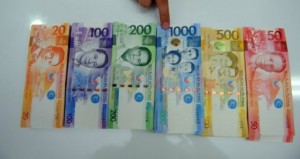Peso breaks into 40-to-$1 territory

The peso on Tuesday, Nov. 27, 2012, rose further to break into the 40-to-a-dollar territory on the back of robust remittances and increased appetite among investors for peso-denominated securities. AFP PHOTO
The peso on Tuesday rose further to break into the 40-to-a-dollar territory on the back of robust remittances and increased appetite among investors for peso-denominated securities.
The local currency closed at a new 56-month high of 40.87 against the greenback, gaining 13 centavos from the previous day’s finish of 41:$1. The intraday high hit 40.85:$1 while the intraday low was 41:$1. Volume of trade amounted to $899.52 million, up from $655.09 million on Monday.
The peso’s movement on Tuesday brought the local currency’s appreciation since the start of the year to about 7 percent, making it one of the strongest currencies in the region.
Despite Tuesday’s gain, the Bangko Sentral ng Pilipinas has maintained that the peso remained competitive. The BSP said that although the appreciation since January was significant, the intraday fluctuations of the peso were still less than those of other currencies in the region.
“The peso has indeed appreciated faster than regional currencies have, but the volatility of the peso has been maintained at the middle of the range (of volatilities of key currencies in the region),” BSP Governor Amando Tetangco Jr. told reporters.
Article continues after this advertisementAccording to the BSP, having moderate day-to-day fluctuations of the peso-dollar rate helped temper disruptions caused by the year-to-date appreciation of the local currency to operations of businesses.
Article continues after this advertisementThe rate of volatility, which indicated how wide or narrow the exchange rate moved around the average for a given period, stood at 1.79 percent for the peso so far this year, Tetangco said. This was more tempered compared with 2.14 percent for the Japanese yen, 2.29 percent for the Australian dollar, 2.33 percent for the Indonesia rupiah and 4.38 percent for the Indian rupee.
The peso’s volatility, however, was faster than the 1.72 percent for the Malaysian ringgit and 1.33 percent for the Thai baht.
Tetangco noted, though, that the BSP would strictly monitor the foreign exchange market to see if there was a pressing need for a more substantial intervention.
“We remain watchful of market conduct,” Tetangco said.
Foreign exchange traders said the BSP had been intervening in the market, arguing that were it not for the dollar-buying of monetary authorities, the peso could have been much stronger that its current level.